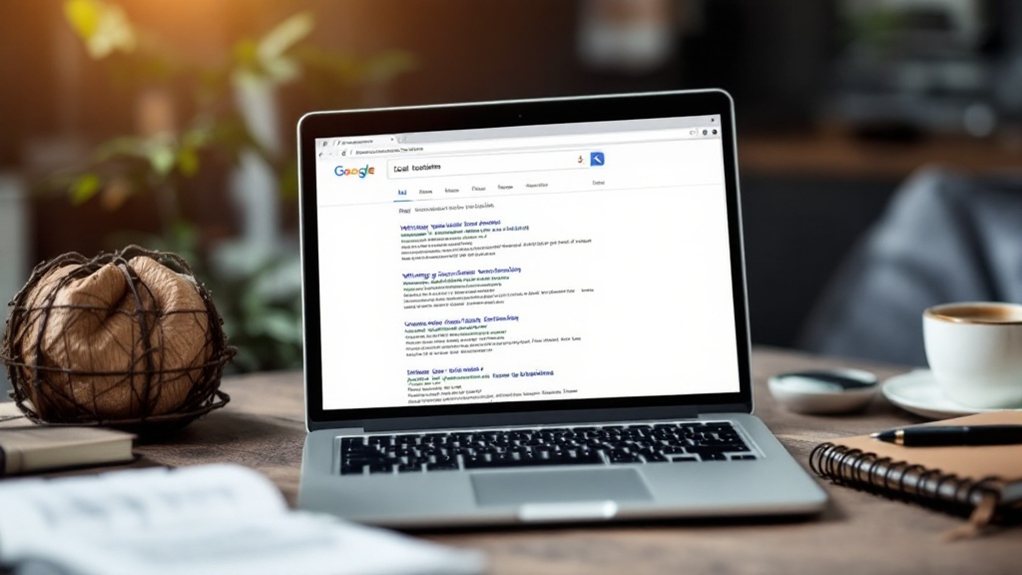As a local business owner, you must strategically select topics that resonate with your target audience, optimize your content for local search, and employ effective promotion tactics to earn high-quality backlinks from authoritative local sources. By analyzing search engine results pages, leveraging keyword research tools, and crafting comprehensive content, you can boost your online visibility and credibility within your community. And to take it a step further, aligning your content with existing link-worthy resources can significantly increase your chances of attracting valuable local backlinks.
Selecting Relevant Topics for Local Audiences

Identifying local market needs is crucial when selecting relevant topics for your audience. Conduct surveys, observe consumer behavior, and analyze market trends and competitor offerings to pinpoint local preferences and challenges. Examining local demographics, spending habits, and competitive dynamics can provide valuable insights. Consider economic indicators, too, as they impact purchasing power and interests. Tailor your content by understanding the age, income, education, culture, and occupations of your target demographic. Leverage local data sources, such as social media analytics and online surveys, to gather insights. Create compelling, SEO-optimized content that addresses specific pain points and summarizes key takeaways. This targeted approach will help you develop content that resonates with your local readership and attracts valuable backlinks.
Analyzing Search Engine Results Pages for Inspiration

As you dive into the process of creating local-focused content, analyzing the search engine results pages (SERPs) can offer invaluable inspiration. By examining the types of SERP features, content formats, and user intent, you can gain insights to craft content that resonates with your local audience. SERP analysis is crucial for understanding search intent, which can guide your content creation.
| SERP Feature | Opportunity |
|---|---|
| Featured Snippets | Provide quick, concise answers to common local queries |
| Local Pack | Highlight your business's location, products, and services |
| Shopping Results | Showcase local product offerings and pricing |
| People Also Ask | Identify related topics of interest to your local community |
| Top Stories | Cover trending local news and events |
Leveraging these SERP insights can help you create content that not only ranks well but also attracts valuable local backlinks.
Leveraging Keyword Research Tools for High-Demand Topics

Keyword research tools are essential for identifying high-demand topics that can drive local backlinks. Targeting the correct search terms forms the basis of every effective local SEO strategy. Understand how to leverage features like competitor analysis, location-based data, and keyword difficulty metrics to uncover profitable opportunities. Strategize your content creation around these insights to boost visibility and attract local engagement.
Analyzing Search Demand
How can you leverage keyword research tools to identify high-demand topics for your local blog content? Start by understanding key metrics like search volume, keyword difficulty, and location-specific analysis. Keyword research drives traffic to the website by providing value, which Google rewards with increased visibility. Tools like Ahrefs, SEMrush, and KWFinder provide valuable insights into search trends and competitive landscape. Incorporate location modifiers, optimize your Google Business Profile, and target long-tail keywords to improve local visibility. Analyze SERP features and consider language variations to cater to your specific audience. Use these search demand insights to craft a content strategy, build topical authority, and optimize for local backlinks through localized content, citations, and community engagement.
Selecting Impactful Keywords
Selecting the right keywords is crucial for crafting local blog content that resonates with your audience and attracts valuable backlinks. [Leverage advanced keyword research tools like Ahrefs, SEMrush, and KWFinder to uncover location-specific search terms with high demand and low competition.] Analyze your competitors' strategies to identify untapped opportunities, and utilize Google Suggest integration to expand your keyword list with long-tail variations. Organize your keywords into topic clusters to enhance content relevance and ensure you're targeting the right audience in your local market. Targeting countries with multiple spoken languages is possible by using KWFinder's language selection feature to identify unique search volumes for specific languages in selected locations. By strategically selecting impactful keywords, you'll set the foundation for creating blog content that drives local engagement and earns high-quality backlinks.
Crafting Comprehensive and In-Depth Content
To truly attract local backlinks, you'll want to leverage the Skyscraper Technique and publish data-driven content. Creating comprehensive, in-depth pieces that offer unique insights or solve specific problems can make your content more valuable and link-worthy. Conducting original research or presenting actionable data can further boost the authority and credibility of your content. By highlighting your expertise and providing tangible value, you can encourage more local websites to link back to your content.
Leverage Skyscraper Technique
Though the Skyscraper Technique may seem straightforward, crafting comprehensive and in-depth content is the key to its success. By covering topics more thoroughly than your competitors, you can create content that truly stands out. This includes:
- Incorporating detailed statistics, case studies, and examples to support your points
- Integrating visuals like infographics and images to enhance reader engagement
- Ensuring your content addresses all relevant subtopics and leaves no gaps
- Focusing on trending or popular search terms and topics to drive the creation of skyscraper content.
Publish Data-Driven Content
Why is publishing data-driven content crucial for crafting comprehensive and in-depth blog posts? Data-backed narratives lend credibility and resonate better with your audience. Begin by analyzing your demographics and interests using analytics. Segment your audience to tailor content effectively. Conduct thorough research, leveraging credible sources to ensure accuracy. Data from credible sources enhances the content's authority. Integrate relevant statistics and facts to reinforce your points. Structure your posts to organize data efficiently, using visual aids like charts and infographics. Regularly measure and refine your content strategy based on performance metrics, adjusting to optimize engagement. Repurpose your data-driven content across various formats to expand your reach.
| Audience Analysis | Research Quality | Content Structure |
|---|---|---|
| Segment by data | Credible sources | Organize with data |
| Tailor content | Comprehensive | Visual aids |
| Resonate better | Enhance credibility | Optimize SEO |
Aligning With Existing Link-Worthy Content
Aligning your content strategy with existing link-worthy pieces ensures you're creating material that resonates with your target audience and has the potential to attract valuable backlinks. Analyze your competitors' link profiles to identify popular content topics, then craft content that provides even better insights or data. Leveraging influencers can help you reach and engage key targets to drive more link building opportunities. Leverage tools like Ahrefs and BuzzSumo to uncover industry influencers and trending content. By aligning your strategy:
- You'll create content that matches potential linkers' needs
- You'll have a better understanding of the type of content that attracts links
- You'll increase your chances of earning backlinks from authoritative sources
Structuring Content for Improved Readability
Ensuring your content is structured for optimal readability is crucial for engaging readers and ranking well in search engines. Leveraging headings and subheadings to clearly delineate sections, and break up information into manageable paragraphs. Short, concise sentences are easier to digest, while strategic use of transition words enhances flow. Incorporate visuals like images and infographics to complement your text and maintain reader interest. Additionally, formatting content into lists and numbered items makes key points scannable and digestible. Using a readability tool can help identify areas for improvement and ensure your content is accessible to a wide audience.
| Heading Hierarchy | Example |
|---|---|
| H1 (Page Title) | Writing Blog Content That Attracts Local Backlinks |
| H2 (Section) | Structuring Content for Improved Readability |
| H3 (Subsection) | Enhancing Clarity with Language |
Optimizing for Local Search Engine Optimization
Optimizing your online presence for local search engine optimization (SEO) is crucial for attracting customers within your geographic area. Leveraging Google Business Profile (GBP) is a powerful strategy, ensuring consistent NAP (name, address, phone) details and managing online reviews. Additionally, securing listings on trustworthy local directories can boost your credibility and visibility. Lastly, incorporating location-specific keywords into your content, from page titles to blog posts, can help you rank higher for relevant local searches.
- Optimize your GBP with complete business details and consistent NAP
- Secure listings on reputable local directories and citations
- Incorporate location-focused keywords throughout your website and content
Incorporating Effective Headline Strategies
Crafting captivating headlines is key to attracting local backlinks. Leverage proven strategies like catchy structures, relevant statistics, and attention-grabbing language to boost reader engagement. By understanding the power of compelling headlines, you can create content that resonates with your local audience and encourages valuable backlinks.
Power of Compelling Headlines
Compelling headlines are the key to capturing readers' attention and driving engagement with your content. By incorporating proven strategies, you can craft irresistible headlines that pique curiosity, elicit emotions, and compel your audience to click.
- Leverage the power of numbers by incorporating eye-catching statistics or odd-numbered lists that stand out.
- Harness the psychological impact of emotional words and phrases that evoke a sense of wonder, urgency, or promise.
- Utilize the curiosity gap by leaving just enough mystery to intrigue your readers and encourage them to delve deeper into your content.
Mastering the art of compelling headlines is a surefire way to boost your blog's visibility, drive traffic, and ultimately, attract valuable local backlinks.
Headline Formulas for Backlinks
While compelling headlines are essential for capturing attention, they're also crucial for attracting valuable local backlinks. Utilize curiosity and urgency with formulas like “Why [Outrageous Claim]” or “Do You Make These [Number] Mistakes?” to create intrigue. Emphasize timeliness with “NOW” or “Time Is Running Out” to encourage immediate action. Leverage social proof and authority by using “The [#] Best” or “Expert-Approved” to build trust. Highlight local relevance with location-specific headlines and incorporate regional keywords to attract local interest. Educate your audience with “The Ultimate Guide To [Topic]” or “How To [Action] Without [Undesirable Outcome].” Finally, encourage engagement by inviting reader participation or feedback.
Optimizing Titles for Local SEO
Optimizing titles for local SEO goes beyond catchy headlines. It requires a strategic approach that balances keywords, location, and user intent.
Start by identifying your core offerings and primary keywords that your target audience is searching for. Incorporate these seamlessly into your title tags, but avoid keyword stuffing. Additionally, include relevant city or regional names to localize your content and appeal to nearby searchers.
- Leverage tools to research search volume and competition for potential keywords.
- Experiment with varying title lengths to find the sweet spot between visibility and informativeness.
- Craft titles that compel users to click through, improving your click-through rates and boosting rankings.
Promoting Content Through Social Media and Outreach
To effectively promote your content through social media and outreach, you'll want to create a distribution pipeline that converts your original blog posts into platform-native social media content. Use scheduling tools to find the best posting times and focus on niche communities, not just major channels. Analyze user journeys and monitor engagement metrics to refine your strategies. Build anticipation by sharing teasers and research findings, then encourage discussion to create a buzz. Collaborate with non-competitive brands through social media swaps to reach new audiences. Add shareable visuals and make it easy for employees to share your content. Partner with relevant influencers and bloggers, offering value in exchange for backlinks and content promotion.
Repurposing and Maintaining Evergreen Content
Why not make the most of your evergreen content by repurposing it across various formats and platforms? Repurposing saves time and resources, enhances reach, and boosts SEO by updating keywords and trends. It allows your content to stay relevant by presenting it in fresh formats, serving multiple stages of the sales funnel effectively.
- Break down long-form content into shorter, digestible pieces for social media.
- Convert text-based content into visuals like infographics and videos.
- Adapt content for different funnel stages: awareness, consideration, and decision.
Remember to monitor content performance regularly, ensure consistent branding, and focus on key insights when repurposing. Adapt content to fit the preferences of your audience segments for maximum impact.
